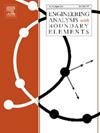An efficient scheme of calculating nearly singular integrals for the 3D BEM modeling of thin media
IF 4.2
2区 工程技术
Q1 ENGINEERING, MULTIDISCIPLINARY
Engineering Analysis with Boundary Elements
Pub Date : 2024-10-30
DOI:10.1016/j.enganabound.2024.106005
引用次数: 0
Abstract
For engineering analysis of 3D problems, common difficulty to apply the boundary element method (BEM) is the so called “nearly singular integrals” that arise when the object is thin or the internal points of analysis are close to the boundary. In the present work, the local integration domain is sub-divided into 4 quadrants at the projection of the source point. By use of the FG-Squircular Mapping, the four quadrants are transformed to 4 quarter-discs for the integrations to be performed under the polar coordinates. As such, the singularity strength is reduced by one order. Thus, the Gauss points can be reasonably increased solely for the integration of the radial distance, while the other integration for the angular parameter remains regular. Such treatment greatly enhances the efficiency of the integration computation. To demonstrate the validity of all presented formulations, a few typical examples are presented to calculate the nearly singular boundary integrals for treating 3D problems of heat transfer as well as elastostatics.
用于薄介质三维 BEM 建模的近奇异积分高效计算方案
在三维问题的工程分析中,应用边界元法(BEM)的常见困难是所谓的 "近奇异积分",当物体较薄或内部分析点靠近边界时会出现这种情况。在本研究中,局部积分域在源点投影处被细分为 4 个象限。通过使用 FG-Squircular Mapping,四个象限被转换为 4 个四分之一圆盘,以便在极坐标下进行积分。因此,奇异性强度降低了一个等级。因此,只需对径向距离进行积分,就可以合理地增加高斯点,而对角度参数的其他积分则保持规则。这种处理方法大大提高了积分计算的效率。为了证明所有公式的有效性,本文列举了几个典型的例子来计算近奇异边界积分,用于处理三维传热和弹性问题。
本文章由计算机程序翻译,如有差异,请以英文原文为准。
求助全文
约1分钟内获得全文
求助全文
来源期刊

Engineering Analysis with Boundary Elements
工程技术-工程:综合
CiteScore
5.50
自引率
18.20%
发文量
368
审稿时长
56 days
期刊介绍:
This journal is specifically dedicated to the dissemination of the latest developments of new engineering analysis techniques using boundary elements and other mesh reduction methods.
Boundary element (BEM) and mesh reduction methods (MRM) are very active areas of research with the techniques being applied to solve increasingly complex problems. The journal stresses the importance of these applications as well as their computational aspects, reliability and robustness.
The main criteria for publication will be the originality of the work being reported, its potential usefulness and applications of the methods to new fields.
In addition to regular issues, the journal publishes a series of special issues dealing with specific areas of current research.
The journal has, for many years, provided a channel of communication between academics and industrial researchers working in mesh reduction methods
Fields Covered:
• Boundary Element Methods (BEM)
• Mesh Reduction Methods (MRM)
• Meshless Methods
• Integral Equations
• Applications of BEM/MRM in Engineering
• Numerical Methods related to BEM/MRM
• Computational Techniques
• Combination of Different Methods
• Advanced Formulations.
 求助内容:
求助内容: 应助结果提醒方式:
应助结果提醒方式:


